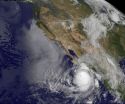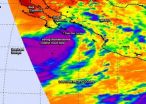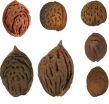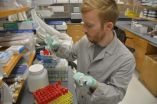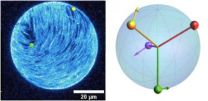(Press-News.org) As Hurricane Norbert continued dropping heavy amounts of rainfall on Mexico's Baja California on September 5, NASA's TRMM satellite calculated the rain that had already fallen.
From its orbit in space, the Tropical Rainfall Measuring Mission or TRMM satellite has the capability of determining how much rainfall has occurred over given areas. Data from TRMM was compiled into a rainfall map that showed the rainfall generated from Tropical Storm Dolly and Hurricane Norbert from August 28 through September 4, 2014.
Tropical storm Dolly dissipated quickly after coming ashore on September 3 in eastern Mexico but dropped heavy rain in some areas near the Gulf coast. At the same time Norbert, then a tropical storm was approaching from the west and contributing to rainfall near Mexico's Pacific coast. TRMM-based, near-real time Multi-satellite Precipitation Analysis (MPA) data for the period from August 28 to September 4, 2014 were used to create an analysis.
The TRMM MPA showed that the heaviest rainfall totals were greater than 300 mm (~11.8 inches) and fell over the open waters of the Pacific Ocean and near Mexico's western and Gulf coasts. Rainfall was also enhanced near inland mountainous terrain when moisture from the tropical cyclones moved over Mexico.
Although Dolly has since dissipated and its moisture moved into the Rio Grande Valley of Texas, Norbert has become a hurricane paralleling the coast of Mexico's Baja California, dropping more heavy rainfall.
When NASA's Aqua satellite passed over Hurricane Norbert on September 4 at 4:17 p.m. EDT, the Atmospheric Infrared Sounder or AIRS instrument captured infrared data that showed cloud top and sea surface temperatures. Sea surface temperatures were warm enough to support Norbert, but cool off farther north, which will help weaken the hurricane. The AIRS image also showed that the coldest cloud top temperatures were colder than -63F/-52C shows the strongest storms and coldest cloud top temperatures in purple. Those strong storms surrounded the center of Norbert and stretched over the southern tip of Baja California in a band of thunderstorms.
A Hurricane Warning is in effect from Santa Fe to Cabo San Lazaro and a Tropical Storm Warning is in effect from San Evaristo to south of Santa Fe and north of Cabo San Lazaro to Punta Eugenia. A Tropical Storm Watch is in effect for north of San Evaristo to Loreto.
The warning area can expect hurricane-force winds and rainfall amounts between 3 to 6 inches over the southern part of the Baja California Peninsula with isolated amounts near 10 inches through Saturday, September 6, according to the National Hurricane Center (NHC). Norbert is also generating very rough seas and large swells affecting the coast of the southern Baja California Peninsula will spread northward along the west coast of the peninsula through the weekend. These swells will produce dangerous surf conditions and rip currents.
Hurricane Norbert's maximum sustained winds were near 90 mph (150 kph) at 8 a.m. EDT (1200 UTC) on Friday, September 5. The NHC expects Norbert to weaken slowly over the next two days.
Norbert's center was located near latitude 23.0 north and longitude 111.9 west, about 125 miles (205 km) west of Cabo San Luca, Mexico. Norbert was moving toward the north-northwest near 8 mph (13 kph) and the NHC expects a turn toward the northwest. On the forecast track the center of the hurricane will continue to move nearly parallel to and just offshore of the pacific coast of the southern Baja California Peninsula through September 6.
As Norbert continues to move in a northerly direction and parallel the Baja California coast, western Mexico, the Gulf of California and southern California will see large swells, rough surf and rip tides.
INFORMATION:
Images: http://www.nasa.gov/content/goddard/norbert-eastern-pacific/
NASA adds up heavy rainfall from Hurricane Norbert
2014-09-05
ELSE PRESS RELEASES FROM THIS DATE:
It's the pits: Ancient peach stones offer clues to fruit's origins
2014-09-05
Anyone who enjoys biting into a sweet, fleshy peach can now give thanks to the people who first began domesticating this fruit: Chinese farmers who lived 7,500 years ago.
In a study published today in PLOS ONE, Gary Crawford, a U of T Mississauga anthropology professor, and two Chinese colleagues propose that the domestic peaches enjoyed worldwide today can trace their ancestry back at least 7,500 years ago to the lower Yangtze River Valley in Southern China, not far from Shanghai. The study, headed by Yunfei Zheng from the Zhejiang Institute of Archeology in China's ...
Like weeds of the sea, 'brown tide' algae exploit nutrient-rich coastlines
2014-09-05
The sea-grass beds of Long Island's Great South Bay once teemed with shellfish. Clams, scallops and oysters filtered nutrients from the water and flushed money through the local economy. But three decades after the algae that cause brown tides first appeared here, much of the sea grass and the bounty it used to provide is gone.
Spring on eastern Long Island is now marked by dense blooms of Aureococcus anophagefferens, which turn estuaries like Great South Bay the color of mud and crowd out native sea grass and stunt or poison shellfish. For years, researchers have puzzled ...
Past sexual assault triples risk of future assault for college women
2014-09-05
BUFFALO, N.Y. -- Disturbing news for women on college campuses: a new study from the University at Buffalo Research Institute on Addictions (RIA) indicates that female college students who are victims of sexual assault are at a much higher risk of becoming victims again.
In fact, researchers found that college women who experienced severe sexual victimization were three times more likely than their peers to experience severe sexual victimization the following year.
RIA researchers followed nearly 1,000 college women, most age 18 to 21, over a five-year period, studying ...
Breast cancer specialist reports advance in treatment of triple-negative breast cancer
2014-09-05
William M. Sikov, a medical oncologist in the Breast Health Center and associate director for clinical research in the Program in Women's Oncology at Women & Infants Hospital of Rhode Island, served as study chair and lead author for a recently-published major national study that could lead to improvements in outcomes for women with triple-negative breast cancer, an aggressive form of the disease that disproportionately affects younger women.
"Impact of the Addition of Carboplatin and/or Bevacizumab to Neoadjuvant Once-Per-Week Paclitaxel Followed by Dose-Dense Doxorubicin ...
Syracuse University physicists explore biomimetic clocks
2014-09-05
Working with a team of scientists from the Technical University of Munich (TU Munich), Brandeis University, and Leiden University in the Netherlands, M. Cristina Marchetti and Mark Bowick, professors in the Soft Matter Program in the Syracuse University College of Arts and Sciences, have engineered and studied "active vesicles." These purely synthetic, molecularly thin sacs are capable of transforming energy, injected at the microscopic level, into organized, self-sustained motion.
Their findings are the subject of a cover-story in the Sept. 5 issue of Science magazine.
The ...
Thousands of nuclear loci via target enrichment and genome skimming
2014-09-05
The use of next-generation sequencing (NGS) technologies in phylogenetic studies is in a state of continual development and improvement. Though the botanically-inclined have historically focused on markers from the chloroplast genome, the importance of incorporating nuclear data is becoming increasingly evident. Nuclear genes provide not only the potential to resolve relationships between closely related taxa, but also the means to disentangle hybridization and better understand incongruences caused by incomplete lineage sorting and introgression.
By harnessing the power ...
Social support: How to thrive through close relationships
2014-09-05
PITTSBURGH—Close and caring relationships are undeniably linked to health and well-being for all ages. Previous research has shown that individuals with supportive and rewarding relationships have better physical and mental health and lower mortality rates. However, exactly how meaningful relationships affect health has remained less clear.
In a new paper, Carnegie Mellon University's Brooke Feeney and University of California, Santa Barbara's Nancy L. Collins detail specific interpersonal processes that explain how close relationships help individuals thrive. Published ...
Dietary recommendations may be tied to increased greenhouse gas emissions
2014-09-05
ANN ARBOR—If Americans altered their menus to conform to federal dietary recommendations, emissions of heat-trapping greenhouse gases tied to agricultural production could increase significantly, according to a new study by University of Michigan researchers.
Martin Heller and Gregory Keoleian of U-M's Center for Sustainable Systems looked at the greenhouse gas emissions associated with the production of about 100 foods, as well as the potential effects of shifting Americans to a diet recommended by the U.S. Department of Agriculture.
They found that if Americans adopted ...
Disease in a dish approach could aid Huntington's disease discovery
2014-09-05
Creating induced pluripotent stem cells or iPS cells allows researchers to establish "disease in a dish" models of conditions ranging from Alzheimer's disease to diabetes. Scientists at Yerkes National Primate Research Center have now applied the technology to a model of Huntington's disease (HD) in transgenic nonhuman primates, allowing them to conveniently assess the efficacy of potential therapies on neuronal cells in the laboratory.
The results were published in Stem Cell Reports.
"A highlight of our model is that our progenitor cells and neurons developed cellular ...
Novel immunotherapy vaccine decreases recurrence in HER2 positive breast cancer patients
2014-09-05
A new breast cancer vaccine candidate, (GP2), provides further evidence of the potential of immunotherapy in preventing disease recurrence. This is especially the case for high-risk patients when it is combined with a powerful immunotherapy drug. These findings are being presented by The University of Texas MD Anderson Cancer Center at the 2014 American Society of Clinical Oncology's Breast Cancer Symposium in San Francisco.
One of only a few vaccines of its kind in development, GP2 has been shown to be safe and effective for breast cancer patients, reducing recurrence ...

